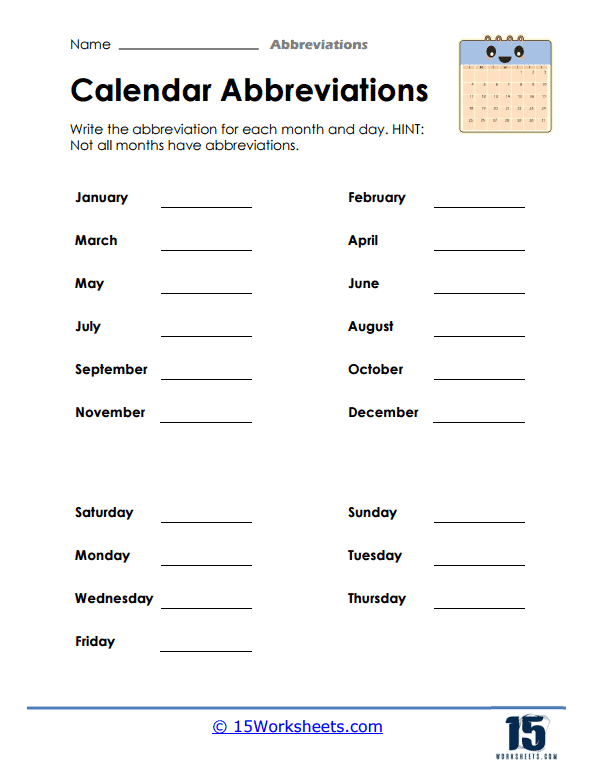Calendar Abbreviations

Worksheet Description
Calendar abbreviations are shortened forms of words or phrases related to the calendar, such as days of the week, months of the year, or specific calendar systems. They are used to save space, simplify communication, and improve the readability of written materials like schedules, agendas, or planners. This worksheet tests students’ skills in knowing the calendar abbreviations for the months of the year and the days of the week.
After completing this calendar abbreviation worksheet, students will be able to:
- Distinguish the calendar abbreviations for the months of the year and the days of the week;
- Use calendar abbreviations efficiently in writing and in speech, and in helping them recall important dates and deadlines better as the abbreviated forms can serve as memory cues for the full terms;
- Appreciate the importance of learning calendar abbreviations.
How Do Calendar Abbreviations Help Students in their Learning?
The usage of calendar abbreviations go beyond the four corners of the classroom, just like any other lessons taught by teachers. Learning calendar abbreviations can be beneficial for students in several ways:
- Time management – Familiarity with calendar abbreviations can help students better manage their time by enabling them to quickly read and understand schedules, agendas, and due dates. This skill can aid in planning and organizing their academic and extracurricular activities.
- Language development – Calendar abbreviations, like other abbreviations, can contribute to students’ overall language development by expanding their vocabulary and enhancing their understanding of language patterns.
- Improved reading comprehension – Understanding calendar abbreviations helps students accurately interpret texts, emails, or other written materials that reference dates or schedules, improving their overall reading comprehension.
- Adaptability – As students become proficient in using and understanding calendar abbreviations, they can more easily adapt to new situations, such as navigating academic or professional environments with different calendar systems or date formats.
- Memory retention – Learning calendar abbreviations can help students better remember important dates and deadlines.
In conclusion, all these skills are essential for students’ academic success and can also be beneficial in everyday life and future professional endeavors.
When Did the Usage of Calendar Abbreviations Begin?
The history of calendar abbreviations can be traced back to various ancient civilizations, which developed their own calendar systems and methods for abbreviating days, months, and years. The use of calendar abbreviations has evolved over time, adapting to changes in language, culture, and communication technologies. The history of calendar abbreviations began in ancient civilizations, where they were used for various purposes, and later on remains to be used widely until today:
- Ancient Rome – The Roman calendar used abbreviations for months and other time-related terms. For example, the Roman numeral “Id” stood for “Ides,” a day in the middle of the month. In addition, the names of the months themselves were derived from Latin roots, many of which have persisted into the modern calendar. The Roman calendar also used the “AUC” system (Ab Urbe Condita, or “from the founding of the city”), which counted years from the legendary founding of Rome.
- Medieval Europe – The use of calendar abbreviations continued during the Middle Ages, particularly among scholars and clergy who used Latin as the primary language for written communication. Abbreviations were used for the names of the days of the week, months of the year, and religious holidays. For example, “Xtmas” was used as an abbreviation for “Christmas,” derived from the Greek letter Chi (Χ) representing Christ.
- Renaissance – With the advent of the printing press, calendar abbreviations became more standardized as printed almanacs, calendars, and books began to circulate. The Gregorian calendar, introduced by Pope Gregory XIII in 1582, replaced the Julian calendar and led to further standardization of calendar terms and abbreviations across Europe.
- Modern Times – In the 20th and 21st centuries, the use of calendar abbreviations has continued to evolve, adapting to the needs of the digital age. As communication technology has advanced, calendar abbreviations have become more widely used in electronic formats, such as emails, text messages, and digital calendars. The standardization of calendar abbreviations has facilitated international communication and the sharing of information across languages and cultures.
To sum it up, the usage of calendar abbreviations has a long history, with origins in ancient civilizations like Rome. The practice has evolved over time to adapt to changes in language, culture, and technology. Today, calendar abbreviations continue to be an important aspect of written communication.
